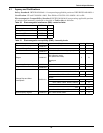
Operation
17
Inverter Asynchronous
This alarm is triggered by an inverter software routine when the inverter and bypass waveforms
are misaligned by more than 6 degrees in phase. This alarm resets automatically once the
condition is no longer true.
1. First check if the alarm “Bypass unable to trace” or “Bypass abnormal” occurs. If so, solve it
first.
2. Verify the waveform of the bypass voltage. If it is too distorted, ask the customer to verify and
seek any possible measurements.
Inverter Fault Inverter output voltage beyond limits. Load transfers to bypass.
Inverter Overtemp.
The temperature of the inverter heat sink is too high to keep inverter running.
This alarm is triggered by the signal from a temperature monitoring thermostat on the inverter
bridge heat sink.
The UPS will recover automatically after a 5 minute delay from the disappearance of the
overtemperature signal.
If the overtemperature condition is true, then check for and verify:
1. high ambient air temperature.
2. blocked cooling airway.
3. any fan failure.
4. prolonged inverter overload
Fan Fault At least one of the cooling fans has failed
Inverter STS Fail
At least one of the static switches of inverter side is open or short circuit. This fault is locked until
power off.
Bypass STS Fail
At least one of the static switches of bypass side is open or short circuit. This fault is locked until
power off
Operation Invalid This record is registered following an incorrect operation:
Output Fuse Fail At least one of the inverter output fuses is blown. Inverter shuts down. Load transfers to bypass.
Control Power 2 Fail UPS operates but Redundant Control Power is not available.
Unit Over load
The UPS is confirmed to be overload when the load arises above 105% nominal rating.
The alarm automatically resets once the overload condition is removed.
1. Confirm that the alarm is true by checking the load percent indicated on the LCD panel to
determine which phase is being overloaded.
2. If the alarm is true, measure the actual output current to verify that the indications are valid.
Disconnect unnecessary load and ensure the safety. In a parallel system, a severe load sharing
error can also leads to the alarm.
System Over load
The UPS parallel system is confirmed to overload when the total load arises above 105%
nominal rating for the set basic number of UPSs. The alarm automatically resets once the
overload condition is removed.
1. Confirm that the alarm is true by checking the system load percent indicated on the LCD
panel to determine which phase is being overloaded.
2. If the alarm is true, measure the actual output current to verify that the indications are valid.
Disconnect unnecessary load and ensure the safety. In a parallel system, a severe load sharing
error can also leads to the alarm.
Unit Over load Timeout
The UPS is confirmed to overload and the overload times out.
Note 1: the highest loaded phase will indicate overload timing-out first.
Note 2: When the timer is active then alarm “unit overload” should also be active as the load is
above nominal.
Note 3: When the timer has expired, the inverter Static Switch is opened and the load
transferred to bypass. The inverter shutdown and will restart after 10 seconds.
Note 4: If the load decreases lower than 95% after 5 minutes, the system will transfer back to
inverter mode.
Confirm that the alarm is genuine by checking the load percent indicated on the LCD. If an
overload is indicated then check the load, and investigate any additional load connected prior to
the alarm (if applicable).
Byp. Abnormal Shutdown Both bypass and inverter voltages unavailable. Load interruption
Inverter Over Current Inverter Pulse Width Modulation module overloaded.
Table 13 RMP messages (continued)
Message Description / Suggested Action (if any)


















